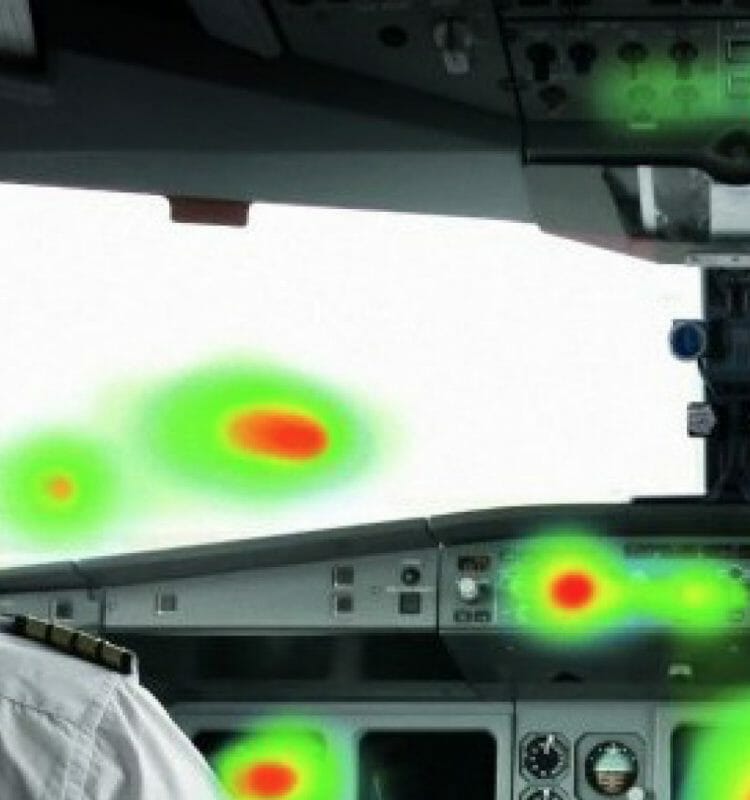EN


In the ever-evolving aviation industry, ensuring top-notch pilot training is essential for safe and efficient flight operations. At Smart Eye, we take pride in pioneering cutting-edge eye tracking technology that goes beyond conventional methods. In this blog post, we delve into the exciting world of pilot evaluation and how our advanced eye tracking solutions have played a pivotal role in transforming training methodologies.
Enter HuMans, a revolutionary pilot training system developed in collaboration with Thales AVS, located just outside of Paris, France. HuMans, utilizing Smart Eye Pro’s superior eye tracking capabilities, has successfully conducted trials in helicopter flight simulators, where pilots operate with an even broader field of view. To ensure real-time gaze data presentation to the instructor, the head tracker incorporates live data forwarding, delivering invaluable insights during the flying session.
But HuMans is just the beginning. As our technology advances, it opens doors to endless possibilities in supporting flight instructors. We explore other innovative training applications, including PilotReady by Eyetracking.com and HinSight by Hinfact, all aimed at optimizing pilot training programs and improving competencies with evidence-based solutions.
At Smart Eye, we believe in the transformative power of eye tracking for pilot training, and the exciting potential it holds for revolutionizing aviation education on a broader scale.
Here we see tools created by SAS SuperHero at the University of Toulouse in France. It was important for the team to use a remote eye tracking system with a wide field of view that provides accurate gaze tracking data with superior data availability. To present gaze data to the instructor in real time, the head tracker must also cater for live data forwarding. The research group with Thales AVS, outside of Paris has developed a prototype called HuMans.
Also, HuMans can be used as a pilot training system and is depending on the Smart Eye Pro to provide eye tracking data. Successful trials were done in helicopter flight simulators. Helicopter pilots operate with an even broader field of view compared to commercial aircraft pilots. Therefore, Thales deployed a five-camera Smart Eye Pro system.
In the right image, you can see a real time view displayed on a tablet held by the instructor during the flying session. On the left picture, you can see a snapshot of the debriefing tool where the pilot and instructor go through the session together by replaying the contents and zooming in on certain events. David Rudy at ETH in Zurich, together with Swiss Lufthansa and NASA conducted a similar kind of study, as well using Smart Eye Pro in the flight simulator cockpit.
Also, this group designed a solution aimed at helping flight instructors, and they call it iAssyst. A three-camera Smart Eye Pro system was used here to gather gaze data. Additional research groups around the world have been doing similar studies, creating prototype systems to help the instructor to better understand under which circumstances a particular pilot has sufficient knowledge, ability and skills, and for what other parts of the training the pilot needs more exercises.
Using eye tracking to support the flight instructor is definitely not a new topic. Based on recent activities on this subject and the number of software prototypes available today for training, we do believe that a commercial deployment of these systems, so-called evidence based training systems on a broader basis is imminent.
Remote eye tracking like Smart Eye Pro provide the basic measurements needed to feed new training and monitoring applications. But it’s also important to note that other players have started to build the actual monitoring and training applications. Here are just a few:
As we conclude this journey into the world of pilot evaluation and training, it becomes evident that eye tracking technology is a game-changer in the aviation industry. Smart Eye’s cutting-edge solutions, such as those leveraged for the HuMans example, have showcased the immense potential of integrating eye tracking data into flight simulators, enabling instructors to gain deeper insights into pilot performance.
Beyond pilot evaluation, our eye tracking technology, in collaboration with innovative applications like PilotReady and HinSight, has ushered in a new era of evidence-based training. The ability to precisely measure pilot gaze behavior and cognitive processes in real-time empowers aviation professionals to optimize training programs, enhance competencies, and elevate safety standards.
At Smart Eye, we remain committed to pushing the boundaries of eye tracking technology, not only in aviation but across various industries. As we move forward, our mission is to continue revolutionizing the way we understand human behavior and interactions, contributing to a safer, more efficient world.
Interested in eye tracking for research? Download our Comprehensive Guide to Eye Tracking Technology for the Aviation Industry here, or contact us today to schedule a demo!
